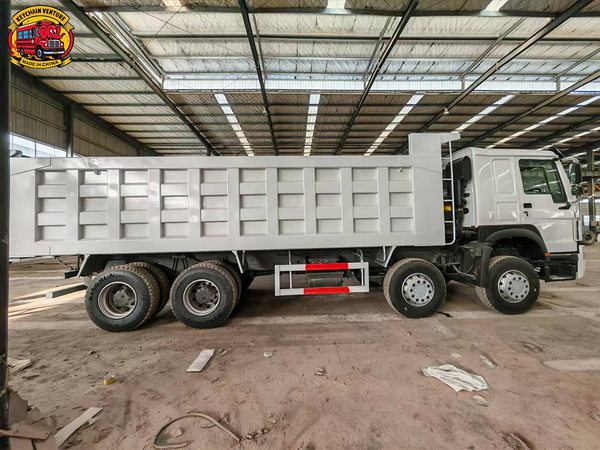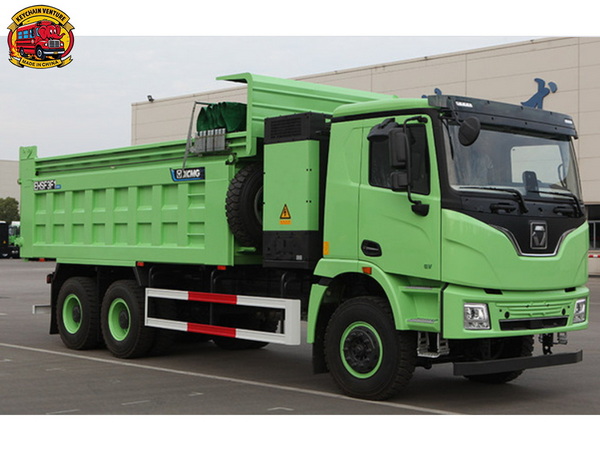Views: 222 Author: Amanda Publish Time: 2025-11-05 Origin: Site








Content Menu
● Understanding Payload and Volume
● The Core Factors That Shape Per-Load Earnings
● Quick Calculations: Estimating Per-Load Profit
● Real-World Scenarios and Their Economics
● Maximizing Earnings Per Load: Practical Strategies
● Industry Trends Shaping the Economics of Dump Trucks
● FAQ
>> 1. How is payload capacity measured for dump trucks?
>> 2. What factors influence the price per load?
>> 3. How many loads can a dump truck haul per day?
>> 4. What are the main operating costs per load?
>> 5. How can a single truck maximize earnings?
KeyChain Venture Co., Ltd. stands at the forefront of China's commercial vehicle supply, delivering high-performance passenger buses and heavy trucks to clients around the world. This article explores the economics of a single dump truck load, unpacking payloads, per-load revenue, operating costs, and practical strategies to maximize profitability. It is written to be useful for fleet managers, operators, and decision-makers considering Dump Truck investments or optimizations.

- Payload refers to how much material a dump truck can carry in a single load, sitting between the bed's capacity and legal weight limits. It is distinct from the vehicle's empty weight and gross vehicle weight (GVW). The difference between GVW and curb weight defines payload capacity, but the practical payload is also constrained by axle load limits and local regulations.
- Different dump truck configurations offer varying payloads. For instance, three-axle and larger models generally enable higher payloads, while smaller urban or light-duty models carry less. Material density matters: lighter materials like sand weigh less per cubic yard than dense rubble or concrete debris, so the same volume can represent different payloads.
- Volume versus weight: many operators price loads by volume (cubic yards) for loose materials, but most regulatory and performance considerations revolve around weight (tons). Understanding the density of typical loads helps translate cubic yards to usable payload figures, ensuring compliance with road rules and maximizing utilization.
- Per-load revenue is primarily governed by the price per unit of material (per ton or per cubic yard) and the load's volume or weight relative to the truck's capacity. Market demand, distance, and contract terms influence pricing, while the material type (soil, gravel, asphalt, construction debris) determines density and thus revenue per load.
- Operating costs per load include fuel consumption, driver wages, maintenance and tire wear, insurance, license/registration, depreciation, and potential tolls. Longer trips typically raise fuel and time costs, while shorter, more frequent trips can increase utilization and reduce per-load overhead if routes are well planned.
- Load efficiency and utilization: a truck that spends less time waiting for loading, tipping, and unloading can complete more loads per day. Efficient loading practices, staging areas, and swift tipping cycles improve throughput and reduce idle time, directly boosting per-load profitability.
- Regulatory limits and compliance: road weight limits, axle load restrictions, and seasonal or route-specific permitting can cap payload per trip. Complying with these rules is essential to avoid fines, detours, or vehicle shutdowns, all of which erode per-load gains.
- Equipment amortization: initial purchase price, financing terms, residual value, and maintenance costs influence the annual and per-load profitability. Heavier, more capable trucks often require higher maintenance but can justify higher rates if reliability and uptime are strong.
- Risk and downtime: weather, breakdowns, and safety incidents reduce the number of successful loads per day and introduce unplanned costs. Proactive maintenance, driver training, and safety programs help stabilize earnings per load.
- Step-by-step approach:
- Determine payload per load in tons or cubic yards, considering material density and the truck's legal limits.
- Establish the price per ton or per cubic yard based on the market segment and contract terms.
- Calculate gross revenue per load: payload quantity × price per unit.
- Subtract per-load operating costs: fuel, driver pay, maintenance, tires, insurance, and depreciation. Include any per-load tolls or permits if applicable.
- Consider idle time and utilization: if the truck sits idle between jobs, per-load profitability declines. Incorporate expected turnaround times into the cost assessment.
- Practical example:
- A typical mid-sized dump truck carries about 10–14 tons per load, depending on configuration and material. If revenue is $25 per ton and operating costs per load total $60 (including fuel, maintenance, and driver wages), the approximate per-load profit would be $190 minus any fixed overhead allocated per load. This illustrates how incremental improvements in payload utilization or cost control can shift profitability meaningfully.
- Important note: some loads are priced by volume (cubic yards) rather than weight. Be prepared to convert density to weight when comparing bids or allocating costs, and document the conversion method for consistency and auditability.
- Construction site hauling: local projects often pay per load or per ton, with price variations driven by distance, job duration, and material type. Short trips with quick tip cycles maximize daily loads and reduce drayage costs.
- Recycling and aggregates: yards that receive multiple materials may offer tiered pricing or volume discounts. Efficient routing and batching of loads can enhance fleet turnover and profitability.
- Mining and quarry operations: higher-density materials produce heavier payloads, but these jobs may require specialized trucks, higher maintenance, and stricter safety protocols. The higher revenue per load can be offset by elevated operating costs and capital expenditure.
- Fleet operations vs. single-truck operations: fleets benefit from routing optimization, preventive maintenance programs, and standardized processes. Individual operators can still achieve strong per-load profitability through tight control of costs and disciplined scheduling.

- Optimize loading and tipping: reduce loading time with pre-staged materials and efficient dump cycles to improve turnaround.
- Route planning and telematics: use GPS-based planning to minimize distance, fuel consumption, and idle time. Real-time telematics support maintenance alerts and driver coaching.
- Maintenance discipline: preventive maintenance reduces unexpected downtime, extends vehicle life, and preserves payload capability by avoiding performance degradation.
- Data-driven performance tracking: monitor payload per load, loads per day, miles per day, and cost per load. Use these metrics to identify bottlenecks and opportunities for improvement.
- Contract design: pursue longer-term contracts with favorable escalation clauses and performance-based incentives. This approach stabilizes revenue and reduces price volatility.
- Safety and compliance: invest in driver training, PPE, and safe operating procedures to minimize incidents, fines, and downtime, thereby protecting earnings per load.
- Telematics and data analytics: real-time monitoring helps optimize utilization, predict maintenance needs, and improve safety. Data-driven decisions support higher payload efficiency and lower per-load costs.
- Emissions and regulatory developments: newer engines and fuel-management solutions can lower fuel consumption and maintenance costs, affecting total cost of ownership and per-load profitability.
- Electrification and alternative fuels: as fleets explore electric or hybrid solutions, capital cost and charging/maintenance considerations influence long-term economics, particularly on shorter routes with frequent stops.
- Global demand cycles: infrastructure investment and commodity markets affect rates and utilization. A well-hedged fleet can adapt by adjusting mix of short-haul and long-haul loads.
- Automation and training: as technology evolves, investing in operator training and fleet software yields better per-load performance through more accurate load placement and safer, faster operations.
In the complex equation of per-load profitability for a Dump Truck, the biggest levers are payload utilization, rate adequacy, and disciplined cost management. By understanding payload profiles, carefully selecting contracts, planning efficient routes, and maintaining equipment diligently, operators can improve earnings per load and sustain healthy margins across varying market conditions. Embracing data-driven decision-making and safety-first practices further reinforces long-term profitability and fleet reliability.

Payload capacity is determined by the difference between gross vehicle weight (GVW) and curb weight (the truck's weight without cargo), expressed in tons or cubic yards, and is influenced by axle configurations and regulatory limits.
Price per load is affected by material type and density, distance traveled, regional demand, contract terms, and any fees or permits required along the route.
The number of loads per day depends on loading speed, unloading cycles, turnaround time, distance, and traffic. Typical daily counts range from several to more than a dozen, depending on efficiency and job scope.
Core costs include fuel, driver wages, maintenance and tires, insurance, depreciation, and any regulatory fees or tolls tied to the route.
Focus on maximizing payload consistency within legal limits, shortening cycle times, planning efficient routes, maintaining high uptime through preventive maintenance, and securing stable contracts with favorable terms.
[1](https://www.grimmsautomovation.com/blog/how-many-tons-can-a-dump-truck-haul-capacity-and-limitations-explained/)
[2](https://freedomheavyhaul.com/dump-truck-weight-limits/)
[3](https://www.lynchtruckcenter.com/manufacturer-information-how-much-can-a-dump-truck-carry.html)
[4](https://constructionmentor.net/standard-on-road-dump-trucks/)
[5](https://www.know-howequipment.com/industry-news/dump-truck-load-capacity-a-comprehensive-overview.html)
[6](https://www.customtruck.com/dump-trucks/16-ft-dump-truck/)
[7](https://mackdefense.com/heavy-dump-truck/)